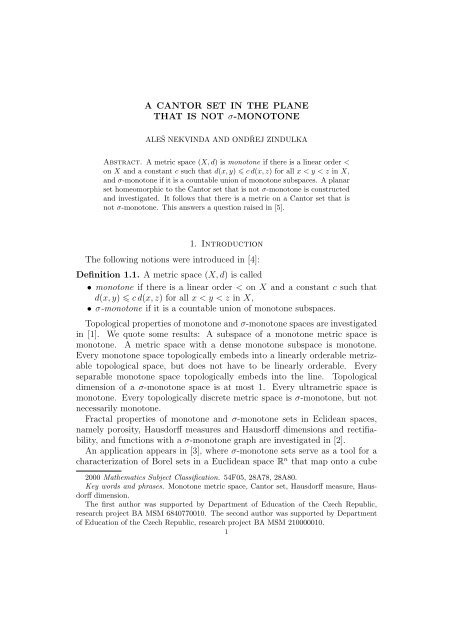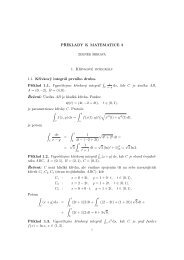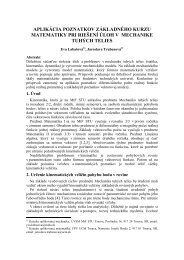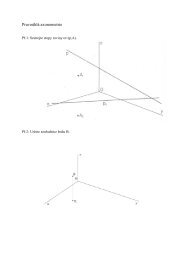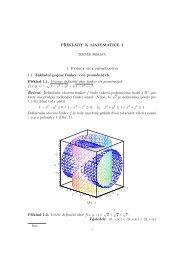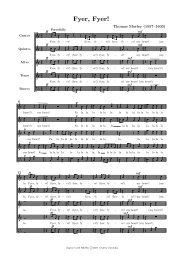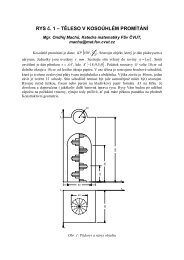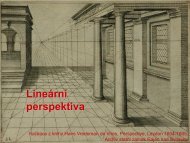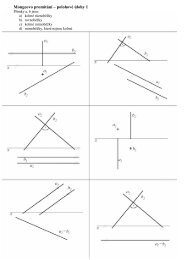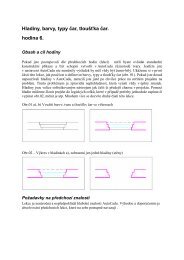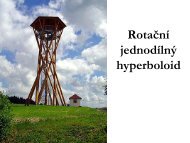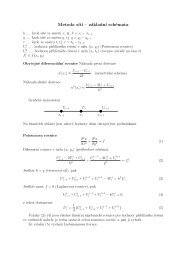A CANTOR SET IN THE PLANE THAT IS NOT Ï-MONOTONE 1 ...
A CANTOR SET IN THE PLANE THAT IS NOT Ï-MONOTONE 1 ...
A CANTOR SET IN THE PLANE THAT IS NOT Ï-MONOTONE 1 ...
Create successful ePaper yourself
Turn your PDF publications into a flip-book with our unique Google optimized e-Paper software.
A <strong>CANTOR</strong> <strong>SET</strong> <strong>IN</strong> <strong>THE</strong> <strong>PLANE</strong><strong>THAT</strong> <strong>IS</strong> <strong>NOT</strong> σ-MO<strong>NOT</strong>ONEALEŠ NEKV<strong>IN</strong>DA AND ONDŘEJ Z<strong>IN</strong>DULKAAbstract. A metric space (X, d) is monotone if there is a linear order
A <strong>CANTOR</strong> <strong>SET</strong> <strong>IN</strong> <strong>THE</strong> <strong>PLANE</strong> <strong>THAT</strong> <strong>IS</strong> <strong>NOT</strong> σ-MO<strong>NOT</strong>ONE 2[0, 1] m (m n) by a quasi-Lipschitz mapping, i.e. a mapping that is β-Hölderfor each β < 1.The very first application of σ-monotone spaces appears in [4]. Let dimand dim H denote, respectively, the topological and Hausdorff dimensions. Itis shown that every analytic σ-monotone metric space X contains a Lipschitzpreimage of every self-similar set S satisfying the strong separation conditionwith dim H S < dim H X. A number of results is derived from this theorem, e.g.:Any analytic metric space X contains a universal measure zero set E ⊆ Xsuch that dim H E dim X; any analytic σ-monotone metric space X containsa universal measure zero set E ⊆ X such that dim H E dim X; and anyanalytic set X ⊆ R n contains a universal measure zero set E ⊆ X such thatdim H E = dim H X.As explained in [4], the following question raised in [5] is of particular interest:Question 1.2 ([5]). Is every compatible metric on the Cantor set σ-monotone?The goal of the present paper is to provide a negative answer to this questionby constructing a set X in the plane that is homemorphic to the Cantor setbut is not, as a metric subspace of the Euclidean plane, σ-monotone.In section 2 we state and prove a combinatorial lemma that is essential forthe construction of the set X. The set X is set up in section 3. In section 4we calculate the linear Hausdorff measure of X and its Hausdorff dimension.In section 5 we prove that every σ-monotone subset of X is contained in aσ-compact set that is meager in X and has linear Hausdorff measure zero. Inparticular, X is not σ-monotone.Throughout the paper we use the following notation and terminology. Ndenotes the set of all positive integers, excluding zero. The cardinality ofa set A is denoted |A|. A metric on a metrizable space is compatible if itinduces the topology of X. If (X, ρ) is a metric space and x ∈ X, the symbolB ρ (x, r) (or just B(x, r)) denotes the closed ball centered at x with radius r.A homeomorphism h : X → Y of two metric spaces is termed bi-Lipschitz ifboth h and its inverse are Lipschitz mappings, and two metric spaces X, Y arebi-Lipschitz equivalent if there is a bi-Lipschitz homeomorphism h : X → Y .We will need the following facts established in [1].Lemma 1.3. A metric space that is bi-Lipschitz equivalent to a monotonespace is monotone.Lemma 1.4. If X is σ-monotone, then it is a countable union of closedmonotone subspaces.
A <strong>CANTOR</strong> <strong>SET</strong> <strong>IN</strong> <strong>THE</strong> <strong>PLANE</strong> <strong>THAT</strong> <strong>IS</strong> <strong>NOT</strong> σ-MO<strong>NOT</strong>ONE 32. PolygonsDefinition 2.1. Let n ∈ N. Consider the cyclic group Z n = {0, 1, . . . , n − 1}.Define a metric on Z nρ n (i, j) = min(|i − j|, n − |i − j|).The metric spaces (Z n , ρ n ) are thought of as abstract regular polygons. Theyserve as building blocks for the construction of X. The following combinatoriallemma is crucial.Lemma 2.2. Let A ⊆ Z n , |A| 3. For each linear order ≺ on A there arei, j, k ∈ A such that i ≺ j ≺ k andρ n (i, j)ρ n (i, k) 1 2|A| − 1n − (|A| − 1) .Proof. Denote |A| = m. If n = m = 3, then 1 = ρ n (i, j) for any distincti, j ∈ A. If n > m = 3, then 1 ρ n (i, j) n for any distinct i, j ∈ A.2In either case, the inequality trivially holds for any triple i, j, k of distinctelements of Z n . We shall thus assume that |A| > 3. Let A = {a z : z ∈ Z m } bethe unique increasing enumeration of A (with respect to the natural orders).Throughout the proof, addition is modulo m. Denote l the integer part ofm/2.Order Z m by z ⊳ z ′ iff a z ≺ a z ′. Let N = {z ∈ Z m : z ⊳ z + l}. If N = ∅,then z ⊲ z + l for all z and thus0 ⊲ l ⊲ 2l ⊲ 3l ⊲ · · · ⊲ ml = 0.Therefore N ≠ ∅. If N = Z m , then z ⊳ z + l for all z and thus0 ⊳ l ⊳ 2l ⊳ 3l ⊳ · · · ⊳ ml = 0.Therefore N ≠ Z m . So there are z 1 ∈ N and z 2 /∈ N. Let z be the last termin the sequence z 1 , z 1 + 1, . . . z 2 − 1 that satisfies z ∈ N. Clearly z + 1 /∈ N.Consider two cases:• z + l ⊳ z + 1: Since z ∈ N, we have z ⊳ z + l ⊳ z + 1. Put i = a z ,j = a z+l and k = a z+1 . Clearly i ≺ j ≺ k. There are at most n − m nodesstrictly between a z and a z+1 . Hence ρ n (i, k) n − (m − 1). There are at leastl − 1 nodes strictly between a z and a z+l both clockwise and counterclockwise.Hence ρ n (i, j) l. Thus(1)ρ n (i, j)ρ n (i, k) ln − (m − 1) 1 2 ·|A| − 1n − (|A| − 1) .• z + l z + 1: Obviously |A| > 3 yields z + l ≠ z + 1. Thus z + l ⊲ z + 1.Since z +1 /∈ N, we have z +1+l⊳z +1⊳z +l. Put i = a z+1+l , j = a z+1 andk = a z+l . Clearly i ≺ j ≺ k. The inequality (1) follows by the same reasoningas above. We are done.□
A <strong>CANTOR</strong> <strong>SET</strong> <strong>IN</strong> <strong>THE</strong> <strong>PLANE</strong> <strong>THAT</strong> <strong>IS</strong> <strong>NOT</strong> σ-MO<strong>NOT</strong>ONE 4Remark 2.3. The set A ⊆ (Z n , ρ n ) in the lemma finite and therefore it is triviallymonotone. The lemma says that a constant witnessing its monotonicitycannot be less than 1 |A|−1. In particular, a constant witnessing monotonicityof (Z n , ρ n ) cannot be less than n−1.2 n−(|A|−1)2Remark 2.4. The particular case A = Z n can be phrased this easy way:Whatever linear order ≺ a regular polygon is equipped with, there are neighboringvertices x, z and a vertex y opposite to them, such that x ≺ y ≺ z.3. Construction of the setIn this section we define a rather regular compact set in the plane that• is homeomorphic to the Cantor set,• has positive and finite Hausdorff length,• is not σ-monotone.The set is constructed in order that every nonempty open subset contains foreach n a bi-Lipschitz copy of the polygon (Z n , ρ n ) described in the previoussection. It is a continuous image of a cartesian product of the groups Z n thatis provided with a suitable metric.Definition 3.1. Let∞∏Z = Z n = {x ∈ (N ∪ {0}) N : x(n) < n for all n ∈ N}.n=1Provide Z with the product topology. Recall Definition 2.1 and define a metricρ on Z by( )ρ n x(n), y(n)ρ(x, y) = sup.n∈N n!Since Z is a countable product of finite topological groups, it is obviously azero-dimensional compact topological group. It has no isolated points. Thusit is homeomorphic to the Cantor ternary set.The verification that ρ is a metric compatible with the topology of Z isstraightforward. Thus (Z, ρ) is a metric space homeomorphic to the Cantorset.Sinceρ n (x(n), y(n))(2) 1 n! n! m m! > ρ m(x(m), y(m))m!whenever n < m and x(n) ≠ y(n), ρ is equivalently described by the followingformula that we shall often use: if x ≠ y, thenρ(x, y) = ρ ( )κ(x,y) x(κ(x, y)), y(κ(x, y)),κ(x, y)!
whereA <strong>CANTOR</strong> <strong>SET</strong> <strong>IN</strong> <strong>THE</strong> <strong>PLANE</strong> <strong>THAT</strong> <strong>IS</strong> <strong>NOT</strong> σ-MO<strong>NOT</strong>ONE 5(3) κ(x, y) = min{n : x(n) ≠ y(n)}.Throughout the paper we adhere to the following notation: Z • = ⋃ ∞m=1∏ mn=1 Z ndenotes the set of initial segments of elements of Z. For E ⊆ Z denoteE • = {p ∈ Z • : p ⊆ x for some x ∈ E}.For p ∈ Z • , [p] = {x ∈ Z : p ⊆ x} denotes the cylinder consisting of allelements of Z that extend p. Note that cylinders are clopen sets that form abase for the topology of Z. Recall that |p| denotes the cardinality=length of p.If p ∈ Z • and k 0 is an integer, then p ⌢ k denotes the usual concatenation.The usual product (=Haar) measure on Z is denoted µ Z . Note that µ Z ([p]) =1|p|!for all p ∈ Z • .We now define a planar set X that is bi-Lipschitz equivalent to the metricspace Z. It is the set announced at the beginning of the section.Definition 3.2. Define a mapping φ : Z → R 2 thus:(∑ ∞cos 2π x(n) ∞)nφ(x) =2(n − 1)! , ∑ sin 2π x(n) ∞∑n=2(n − 1)!n=1n=1n=1(expLet X = φ(Z) ⊆ R 2 and provide it with the Euclidean metric.Proposition 3.3. φ : (Z, ρ) → X is bi-Lipschitz.2πi x(n)n2(n − 1)!Proof. Let x, y ∈ Z, x ≠( y. Throughout ) the proof we use the following notation:κ = κ(x, y), j = ρ κ x(κ), y(κ) ,( ) ( )S n = exp − exp .2πi x(n)n2πi y(n)nNote that κ 2, j 1 and ρ(x, y) = j κ! .Since S n = 0 for all n < κ and |S n | 2 for all n,(4)(The vectors exp∞|S κ |2(κ − 1)! − ∑n=κ2πi x(κ)κ1n! |φ(x) − φ(y)| |S ∞κ|2(κ − 1)! + ∑n=κ) ( )and exp2πi y(κ)κ(5) |S κ | = 2 sin 2πj/κ21n! .)span angle 2πjκ . Therefore= 2 sin πjκ .Use elementary estimates 2 t sin t t that hold for all t ∈ [0, π/2] to getπ(6)4jκ |S κ| 2πjκ ..
A <strong>CANTOR</strong> <strong>SET</strong> <strong>IN</strong> <strong>THE</strong> <strong>PLANE</strong> <strong>THAT</strong> <strong>IS</strong> <strong>NOT</strong> σ-MO<strong>NOT</strong>ONE 6The set X = φ(Z). The two triangular shapes are centered at the endpointsof a segment. The six square shapes are centered at the verticesof the triangles. The twenty four pentagonal shapes are centered at thevertices of the squares, et cetera ad infinitum. One of the vertices of thepentagons is shown magnified in the circle.One more inequality we need:∞∑ 1(7)n! 1 ∞∑ 1κ! (κ + 1) 1 (1 + 1 )i κ! κn=κi=0Combining these inequalities with (4) and reminding that κ 2 and ρ(x, y) =jyields on one handκ!|φ(x) − φ(y)| and on the other hand|φ(x) − φ(y)| 1 πj(κ − 1)! κ + 3/2κ!1 2j(κ − 1)! κ − 3/2κ!which shows that φ is bi-Lipschitz. j κ! j κ!(π + 3/2 ) ρ(x, y)(π + 3/2)j(2 − 3/2 ) 1 ρ(x, y),j 2Most properties of Z and its subsets we are after, e.g. monotonicity, Hausdorffmeasure zero, Hausdorff dimension, meagerness, are bi-Lipschitz invariant.Thus, as to these properties, Z and X are indistinguishable. In the nextsection we show that the mapping φ actually preserves, up to a factor 2, alsoHausdorff measure.□
A <strong>CANTOR</strong> <strong>SET</strong> <strong>IN</strong> <strong>THE</strong> <strong>PLANE</strong> <strong>THAT</strong> <strong>IS</strong> <strong>NOT</strong> σ-MO<strong>NOT</strong>ONE 74. Hausdorff measure of the setWe now calculate Hausdorff measures and dimensions of Z and X. The s-dimensional Hausdorff measure and related approximation pre-measures aredenoted H s and H s δ , respectively, and dim H denotes Hausdorff dimension. Arefinement of the above proposition is needed:Lemma 4.1. For each ε > 0 there is δ > 0 such that if ρ(x, y) < δ, then|φ(x) − φ(y)| (2 − ε)ρ(x, y).Proof. Fix ε > 0 small enough to satisfy(8)π(1 − ε) − (1 + ε) 2.Choose m ∈ N subject to ε > 1 m and(9)sin t (1 − ε)t whenever 0 t 2πεmand put δ = 1 . m!We appeal to the above proof, including notation. Suppose ρ(x, y) < δ.Then κ m. Combine (7) with ε > 1 and (4) to getκ(10) |φ(x) − φ(y)| |S κ|2(κ − 1)! − 1 + ε .κ!Distinguish two cases: If j 2/ε, use (10) and (6):|φ(x) − φ(y)| 2jκ! − 1 + ε = 2j (1 − 1 + ε )κ! κ! 2j 2j (1 − ε 1 + ε ) 2j (1 − ε ) ρ(x, y)(2 − ε).κ! 4 κ! 2If j < 2/ε, use (10), (5), (9) with t = πjκ|φ(x) − φ(y)| 2πj(1 − ε)2κ!− 1 + εκ!and (8):= j κ!(π(1 − ε) − 1 + ε )j ρ(x, y) ( π(1 − ε) − (1 + ε) ) 2ρ(x, y).Proposition 4.2. (i) H 1 (E) = 1µ 2 Z(E) for any Borel set E ⊆ Z. In particular,H 1 (Z) = 1 and dim 2 H Z = 1.(ii) H 1 (E) = 2H 1 (φ −1 [E]) = µ Z (φ −1 [E]) for any Borel set E ⊆ X. In particular,H 1 (X) = 1 and dim H X = 1.Proof. We prove (i) first. For n ∈ N denote [n/2] the integer part of n/2. Notethat for all p ∈ Z •(11) diam[p] =[(|p| + 1)/2](|p| + 1)! 12|p|! .□
A <strong>CANTOR</strong> <strong>SET</strong> <strong>IN</strong> <strong>THE</strong> <strong>PLANE</strong> <strong>THAT</strong> <strong>IS</strong> <strong>NOT</strong> σ-MO<strong>NOT</strong>ONE 8Let A ⊆ Z be a Borel set. We first estimate diam A from below by µ Z (A). Sincethe closure A of A is compact, there are x, y ∈ A such that ρ(x, y) = diam A.Therefore there are unique n ∈ N and j [n/2], such that diam A = j n! .Hence there is p ∈ Z • , |p| = n − 1 such that A ⊆ [p] and ρ n (x(n), y(n)) jfor all x, y ∈ A. Consequently:• If j < [n/2], then there is i ∈ Z n such that x(n) ∈ {i, i + 1, . . . , i + j} forall x ∈ A. It follows that A ⊆ ⋃ i+jk=i [p⌢ k ]. Therefore (11) yieldsi+j∑µ Z (A) µ Z ([p ⌢ k ]) = (j + 1) 1 n! = j + 1 j 2 diam A.j n!k=i• If j = [n/2], then A ⊆ [p] and (11) yieldµ Z (A) µ Z ([p]) =1(n − 1)! = n [n/2][n/2] n! 2n diam A.n − 1In either case, diam A 1(1 − 1 )µ 2 n Z(A).Let now E be a Borel set. Let m ∈ N and δ < 1 and suppose {Am! k }be a cover of E by Borel sets of diameters at most δ. Then diam A k 12(1 −1m)µZ (A k ) for all k. Thus∑diam A k 1 (1 − 1 ) ∑µ Z (A k ) 1 2 m2kk(1 − 1 )µ Z (E).mTherefore Hδ 1(E) 2( 1 1 −1m)µZ (E). Let m → ∞ to get H 1 (E) 1µ 2 Z(E).To prove the opposite inequality it suffices to show H 1 (Z) 1 . Let m and2δ be as above and cover Z by the family E = {[p] : p ∈ Z • , |p| = m}. Since|E| = m!, (11) yieldsHδ(Z) 1 ∑1diam[p] m! ·2m! = 1 2 .|p|=mLet m → ∞ to get H 1 (Z) 1.2∑The family E can be also used to show that H 1 (X) 1: Since diam φ([p]) ∞ 1n=|p|for all p ∈ Z • , one may use (7) to show that given any ε > 0 theren!is m large enough so that the family {φE : E ∈ E} is a cover of X by setsof diameters below 1+ε and thus witnesses H 1 m! δ (X) 1 + ε. Let m → ∞ andε → 0 to get H 1 (X) 1.It remains to prove that H 1 (E) 2H 1 (φ −1 [E]) = µ Z (φ −1 [E]) for every setE ⊆ X. But that follows immediately from Lemma 4.1 and part (i). □5. The set is not σ-monotoneWe now show that large subsets of Z and X are not σ-monotone. To thatend we prepare a combinatorial lemma.
A <strong>CANTOR</strong> <strong>SET</strong> <strong>IN</strong> <strong>THE</strong> <strong>PLANE</strong> <strong>THAT</strong> <strong>IS</strong> <strong>NOT</strong> σ-MO<strong>NOT</strong>ONE 9Definition 5.1. Let E ⊆ Z. For p ∈ E • denotedeg E (p) = |{k ∈ Z |p|+1 : p ⌢ k ∈ E • }|the number of immediate successors of p in E • .Say that a node p ∈ E • is bad if)∀α < 1 ∀n ∈ N ∃q ∈ E(p • ⊆ q & |q| n & deg E (q) > α(|q| + 1) .Say that a node p ∈ E • is good if it is not bad, i.e. if()(12) ∃α < 1 ∃n ∈ N ∀m n p ⊆ q & |q| m =⇒ deg E (q) α(|q| + 1) .Lemma 5.2. If E ⊆ Z is monotone, then each node p ∈ E • is good.Proof. Suppose < and c are the order and constant witnessing monotonicity2cof E. Choose n ∈ N such that + 12c< 1 and set α = + 1 . Aiming1+2c n+1 1+2c n+1towards contradiction assume there is a bad node p ∈ E • . Thus there is anextension q ⊇ p such that |q| n and deg E (q) > α(|q| + 1). Therefore( )2cdeg E (q) − 1 >1 + 2c + 12c(|q| + 1)(|q| + 1) − 1 = .(|q| + 1)1 + 2cDenote m = |q| + 1 and A = {a ∈ Z m : q ⌢ a ∈ E • }. Clearly |A| = deg E (q). Foreach a ∈ A choose x a ∈ E such that q ⌢ a ⊆ x a . Order A by a ≺ b iff x a < x b .Since < is a linear order, so is ≺. Now apply Lemma 2.2: There are i, j, k ∈ Asuch that i ≺ j ≺ k andρ m (i, j)ρ m (i, k) 1 2|A| − 1m − (|A| − 1) = 1 2deg E (q) − 1m − (deg E (q) − 1) > 1 22cm1+2cm − 2cm1+2c= c.Since ρ(x a , x b ) = ρm(a,b) for all a, b ∈ A, the latter estimate yields ρ(xm! i , x j ) >cρ(x i , x k ) and since clearly x i < x j < x k , the points x i , x j , x k ∈ E breakmonotonicity of E: a contradiction.□Theorem 5.3. If E ⊆ X is σ-monotone, then there is an F σ -set F ⊇ E thatis meager (in X) and such that H 1 (F ) = 0. In particular, E is meager andH 1 (E) = 0.Proof. According to Lemma 1.3 and Propositions 3.3 and 4.2 we may work inZ. Due to Lemma 1.4 E may be assumed F σ . Since meagerness and measurezero are countably additive properties, we may actually assume that E isclosed and monotone. By the preceding lemma any node p ∈ E • satisfiescondition (12). Consequently there is α < 1 such thatµ Z ({x ∈ E : p ⊆ x}) ∏ αmm = ∏ α = 0.m>n m>n
A <strong>CANTOR</strong> <strong>SET</strong> <strong>IN</strong> <strong>THE</strong> <strong>PLANE</strong> <strong>THAT</strong> <strong>IS</strong> <strong>NOT</strong> σ-MO<strong>NOT</strong>ONE 10Since E • is countable and E ⊆ ⋃ p∈E • {x ∈ E : p ⊆ x}, it follows thatµ Z (E) ∑ p∈E • µ Z ({x ∈ E : p ⊆ x}) = 0.Apply Proposition 4.2 to get H 1 (E) = 0 and notice that if E were not meager,being closed it would contain a nonempty open set and thus would havepositive measure.□Since X is homeomorphic to the Cantor set, the theorem yields a negativeanswer to Question 1.2:Corollary 5.4. There is a compatible metric on the Cantor set that is notσ-monotone.The theorem says that σ-monotone subsets of X are small as to measure andcategory. There, however, are monotone sets of large Hausdorff dimension.Perhaps it is not incidental: What if any compatible metric on the Cantor setadmits a σ-monotone subset of full Hausdorff dimension? To date we do nothave much to say about this phenomenon.Proposition 5.5. There is a monotone closed set F ⊆ X such that dim H F =1.Proof. Work in Z. Use the idea and notation of the proof of Proposition 4.2.For each n ∈ N set F n = {0, 1, . . . , [n/2]} and define∞∏F = F n = {x ∈ Z : x(n) [n/2]}.n=1F is obviously compact. We first show that dim H F = 1. Let µ F be theuniformly distributed product measure on F . Clearly(13) µ F ([p] ∩ F ) =|p|∏i=1|p|1[i/2] + 1 ∏i=12i = 2|p||p|! , p ∈ F • .Proceed the same way as in the proof of Proposition 4.2: Let A ⊆ F bea Borel set and let n, j ∈ N, j [n/2] be the unique numbers such thatdiam A = j n! . There is p ∈ F • , |p| = n − 1 such that A ⊆ [p] ∩ F andρ n (x(n), y(n)) j for all x, y ∈ A.• If j < [n/2], then there is i ∈ Z n such thati+j∑µ F (A) µ F ([p ⌢ k ] ∩ F ) (13) (j + 1) 2nn! .k=i• If j = [n/2], then A ⊆ [p]. Henceµ F (A) µ F ([p] ∩ F ) (13)2n−1(n − 1)! = n 22 nn! ([n/2] + 1)2nn! .
A <strong>CANTOR</strong> <strong>SET</strong> <strong>IN</strong> <strong>THE</strong> <strong>PLANE</strong> <strong>THAT</strong> <strong>IS</strong> <strong>NOT</strong> σ-MO<strong>NOT</strong>ONE 11In either case we have(14) µ F (A) 2n (j + 1).n!Fix s < 1 and let m ∈ N be large enough so that n2 n (n!) 1−s holds for alln m. Then2 n (j + 1)( n2n (n!)1−s 1) s ( j s n! n! n! n! n!)whenever n m and 1 j [n/2]. So if diam A 1 , then (14) yieldsm!µ F (A) (diam A) s . It follows that if F is covered by a family {A k } of setswith diameters not exceeding 1 , thenm!∑(diam A k ) s ∑ (⋃ )µ F (A k ) µ F A k µF (F ) = 1.kkTherefore H s (F ) H1/m! s (F ) µ F (F ) = 1. Since s < 1 was arbitrary, weconclude that dim H F = 1.It remains to show that F is monotone. Let < be the lexicographic orderon F . Assume x < y < z. There are three possible configurations (recall (3)):• κ(x, z) = κ(y, z) < κ(x, y): Then (2) yields ρ(x, y) ρ(x, z).• κ(x, z) = κ(x, y) < κ(y, z): Then (2) yields ρ(x, y) = ρ(x, z).• κ(x, y) = κ(x, z) = κ(y, z): Let κ denote this common value. Sincex < y < z, we have 0 x(κ) < y(κ) < z(κ) [κ/2]. Thereforeρ κ (x(κ), z(κ)) = z(κ) − x(κ) > y(κ) − x(κ) = ρ κ (x(κ), y(κ))and thus ρ(x, z) ρ(x, y), as required.There are also non-σ-monotone subsets of X with small Hausdorff dimension:Proposition 5.6. There is a closed set F ⊆ X with dim H F = 0 that is notσ-monotone.Proof. Work in Z. Choose a strictly increasing sequence 〈n k : k ∈ N〉 suchthatn 1 n 2 . . . n k (n k !) 1/k(n k = 4 k will do), put I = {n k : k ∈ N} and setF = {x ∈ Z : x(n) = 0 if n /∈ I}.Fix s > 0 and let k ∈ N be arbitrary subject to 1/k < s. Consider the familyE = {[p] : p ∈ F • , |p| = n k }. It is obviously a cover of F and |E| = n 1 n 2 . . . n k .According to (11) diam E 1n kfor each E ∈ E. Therefore!H1/n s k !(F ) ∑ ( 1) s ( 1) 1/k(diam E) s n 1 n 2 . . . n k (nk !) 1/k = 1.n k !n k !E∈ELet k → ∞ to get H s (F ) 1. Since this holds for all s > 0, we get dim H F = 0.k□
A <strong>CANTOR</strong> <strong>SET</strong> <strong>IN</strong> <strong>THE</strong> <strong>PLANE</strong> <strong>THAT</strong> <strong>IS</strong> <strong>NOT</strong> σ-MO<strong>NOT</strong>ONE 12It remains to show that F is not σ-monotone. Assume the contrary. SinceF is compact, using Lemma 1.4 and the Baire category theorem there is anonempty open (in F ) set U that is monotone. There is p ∈ F • such that[p] ∩ F = {x ∈ F : p ⊆ x} ⊆ U. Since deg U (q) = n k for any k ∈ N andany q ∈ U • of length n k − 1, the node p is bad (for U). Apply Lemma 5.2to conclude that U is not monotone: a contradiction proving that F is notσ-monotone.□References1. Aleš Nekvinda and Ondřej Zindulka, Monotone metric spaces, to appear.2. Ondřej Zindulka, Fractal properties of monotone sets, to appear.3. , Mapping Borel sets onto balls by Lipschitz and quasi-Lipschitz maps, to appear.4. , Universal measure zero, large Hausdorff dimension, and nearly Lipschitz maps,Fund. Math., to appear.5. , Is every metric on the Cantor set σ-monotone?, Real Analysis Exchange 33(2008), no. 2, 485.Department of Mathematics, Faculty of Civil Engineering, Czech TechnicalUniversity, Thákurova 7, 160 00 Prague 6, Czech RepublicE-mail address: nales@mat.fsv.cvut.cz, zindulka@mat.fsv.cvut.czURL: http://mat.fsv.cvut.cz/zindulka


